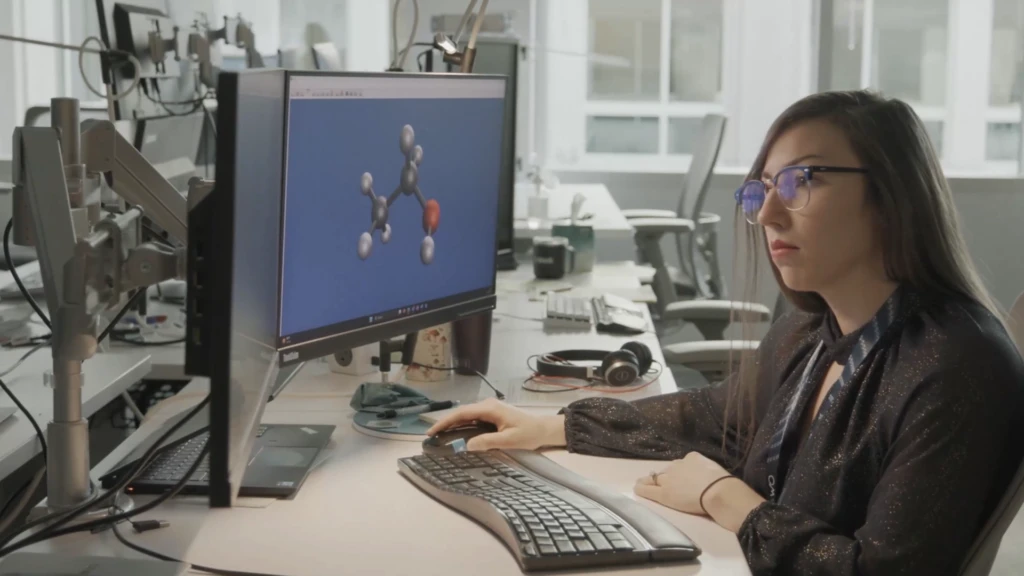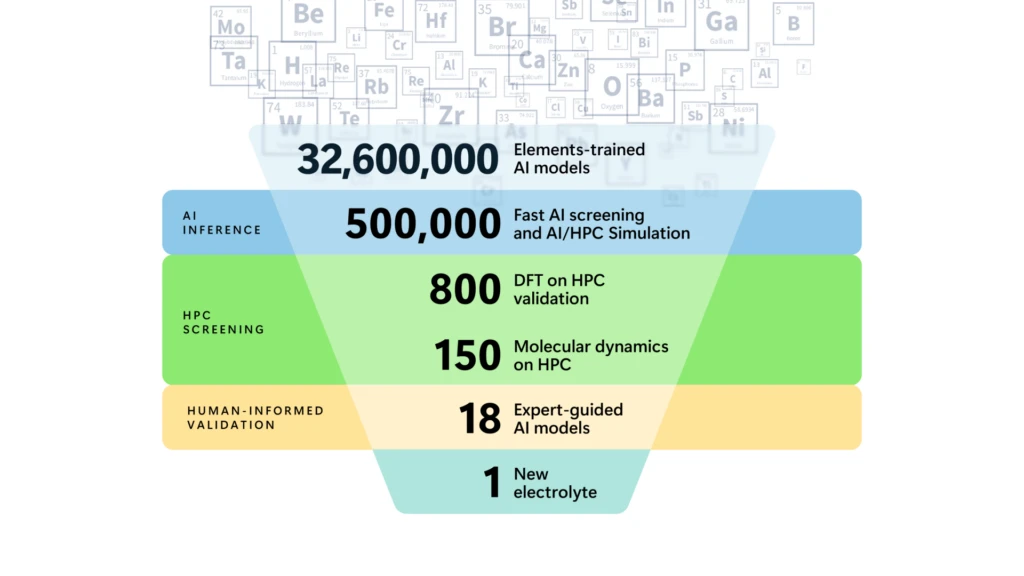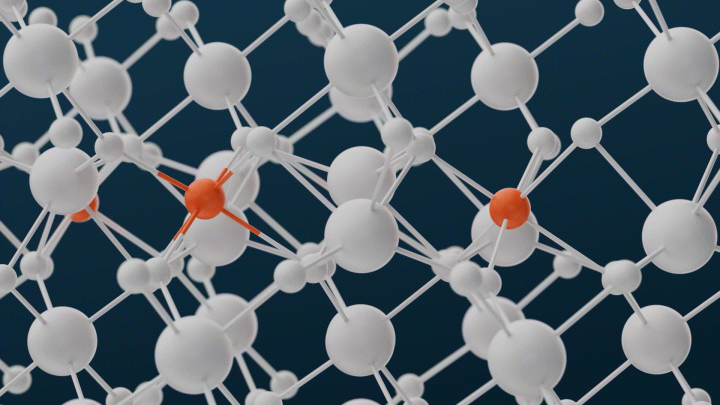
AI is transforming every cognitive task we perform, from writing an email to developing software. Since the dawn of civilization, scientific discovery has been the ultimate cognitive task that has made us thrive and prosper as a species. For this reason, scientific discovery has probably the highest impact and is the most exciting use case for AI. We are announcing how the Microsoft Quantum team achieved a major milestone toward that vision, using advanced AI to screen over 32 million candidates to discover and synthesize a new material that holds the potential for better batteries—the first real-life example of many that will be achieved in a new era of scientific discovery driven by AI.
We believe that chemistry and materials science are the hero scenario for full-scale quantum computers. That led us to design and launch Azure Quantum Elements, a product built specifically to accelerate scientific discovery with the power of AI, cloud computing, and eventually, full-scale quantum computers. Our beliefs were confirmed by working with companies like Johnson Matthey, 1910 Genetics, AkzoNobel, and many others, which led to the launch of Azure Quantum Elements in June. Over the summer, we had already demonstrated a massive screening of materials candidates, but we knew that showing what might be possible is not the same thing as proving the technology could identify something new and novel that could be synthesized. We needed a real proof point and decided to start with something useful from everyday life to hyperscale data centers: battery technology.
As demonstrated in results published in August, we used novel AI models to digitally screen over 32 million potential materials and found over 500,000 stable candidates. However, identifying candidates is only the first step of scientific discovery. Finding a material among those candidates with the right properties for the task, in this case for a new solid-state battery electrolyte, is like finding a needle in a haystack. It would involve lengthy high-performance computing (HPC) calculations and costly lab experimentation that would take multiple lifespans to complete.
Today we are sharing how AI is radically transforming this process, accelerating it from years to weeks to just days. Joining forces with the Department of Energy’s Pacific Northwest National Laboratory (PNNL), the Azure Quantum team applied advanced AI along with expertise from PNNL to identify a new material, unknown to us and not present in nature, with potential for resource-efficient batteries. Not only that, PNNL scientists synthesized and tested this material candidate from raw material to a working prototype, demonstrating its unique properties and its potential for a sustainable energy-storage solution, using significantly less lithium than other materials announced by industry.
This is important for many reasons. Solid-state batteries are assumed to be safer than traditional liquid or gel-like lithium batteries, and they provide more energy density. Lithium is already relatively scarce, and thus expensive. Mining it is environmentally and geopolitically problematic. Creating a battery that might reduce lithium requirements by approximately 70% could have tremendous environmental, safety, and economic benefits.
This collaboration is just the beginning of an exciting new journey bringing the power of AI to nearly every aspect of scientific research. More broadly, Microsoft is putting these breakthroughs into customers’ hands through our Azure Quantum Elements platform. It is the combination of scientific expertise and AI that will compress the next 250 years of chemistry and materials science innovation into the next 25, transforming every industry and ultimately unlocking a new era for scientific discovery.
You can learn more about Microsoft’s approach that enabled this rapid scientific discovery in the following paper.
The need for sustainable energy sources
Many of the hardest problems facing society, like reversing climate change, addressing food insecurity, or solving energy crises, are related to chemistry and materials science. We’ve long believed that materials discovery is a key scenario for tackling some of these issues, but time is our greatest challenge—the number of possible stable materials that must be explored to find solutions is believed to surpass the number of atoms in the known universe. That’s why at Microsoft, we recently released Azure Quantum Elements. Our cloud platform brings together a new generation of AI, cloud-powered HPC, and eventually quantum computing breakthroughs to empower our partners with the right tools to drive innovation by accelerating their discovery pipeline and dramatically reducing the time to screen new candidates.
PNNL advances the frontiers of knowledge, taking on some of the world’s greatest science and technology challenges. Distinctive strengths in chemistry, Earth sciences, biology, and data science are central to its scientific discovery mission. PNNL has established leadership in developing and validating next-generation energy storage technologies. Among the most recognizable forms of portable energy storage, lithium-ion batteries remain a cornerstone of modern portable energy storage because of their high energy-storage capacity and long lifespan.
“Lithium and other strategic elements used in these batteries are finite resources with limited and geographically concentrated supplies. One of the main thrusts of our work at PNNL has been identifying new materials for increased energy storage needs of the future; ones made with sustainable materials that conserve and protect the Earth’s limited resources.”
—Vijay Murugesan, Group Leader—Materials Science, PNNL.
Through this collaboration, Microsoft and PNNL harnessed AI and cloud-powered HPC to accelerate research aimed at creating new types of battery materials—such as those that use less lithium than traditional lithium-ion batteries, while maintaining significant conductivity. These new types of batteries could benefit both the environment and consumers. Within nine months, PNNL validated this proof-of-concept, demonstrating the potential of new HPC and AI approaches to significantly accelerate the innovation cycle—it would be impossible for researchers to synthesize and test the millions of materials that were evaluated by advanced AI models in less than a week.
Accelerating computational materials discovery with AI
To achieve these results, our Azure Quantum team at Microsoft combined cloud-powered HPC calculations with new AI models that estimate characteristics of materials related to energy, force, stress, electronic band gap, and mechanical properties. These models have been trained on millions of data points from materials simulations and are thus able to minimize HPC calculations and predict materials properties 1,500 times faster than traditional density functional theory (DFT) calculations.
We began with 32.6 million candidate materials, created by substituting elements in known crystal structures with a sampling of elements across a subset of the periodic table. As a first application, we filtered this set of candidates using a workflow that combined our AI models of materials with conventional HPC-based simulations.
The first stage of screening—published in August—used AI models. From the initial pool of 32.6 million materials, we found 500,000 materials predicted to be stable. We used AI models to screen this pool of materials for functional properties like redox potential and band gap, further reducing the number of potential candidates to about 800. The second screening stage combined physics simulations with the AI models. Microsoft Azure HPC was used for DFT calculations to confirm the properties from AI screening. AI models have a non-zero prediction error, so the DFT validation step is used to re-compute the properties that the AI models predicted as a higher-accuracy filter. This step was followed by molecular dynamics (MD) simulations to model structural changes.
Then, our Microsoft Quantum researchers used AI-accelerated MD simulations to investigate dynamic properties like ionic diffusivity. These simulations used AI models for forces at each MD step, rather than the slower DFT-based method. This stage reduced the number of candidates to 150. Then, practical features such as novelty, mechanics, and element availability were taken into consideration to create the set of 18 top candidates.

From there, PNNL’s expertise provided insights into additional screening parameters that further narrowed the final structural candidates. The researchers at PNNL then synthesized the top candidate, characterized its structure, and measured its conductivity. The new electrolyte candidate uses approximately 70% less lithium compared to existing lithium-ion batteries, by replacing some lithium with sodium, an abundant compound.
In tests across a range of temperatures, the new compound displayed viable ionic conductivity, indicating its potential as a solid-state electrolyte material. After verifying the conductivity of the sodium-lithium chemical composition, the PNNL research team demonstrated the electrolyte’s technical viability by building a working all-solid-state battery, which was tested at both room temperature and high temperature (~80 °C).

The discovery of this new type of electrolyte material is notable not only for its potential as a sustainable energy-storage solution, but also because it demonstrates that researchers can dramatically accelerate time to results with advanced AI models. While further validation and optimization of the material is ongoing, this initial end-to-end process took less than nine months and is the first step in a promising collaboration between Microsoft and PNNL. The discovery of other materials that could increase the sustainability of energy storage is likely on the horizon.
“We bring our scientific expertise to bear on picking the most promising material candidates to move forward with. In this case, we had the AI insights that pointed us to potentially fruitful territory so much faster. After Microsoft’s team discovered 500,000 stable materials with AI that could be used across a variety of transformative applications, we were able to modify, test, and tune the chemical composition of this new material and quickly evaluate its technical viability for a working battery, showing the promise of advanced AI to accelerate the innovation cycle.”
—Karl Mueller, Program Development Office Director, PNNL.

Looking ahead toward a quantum future
This achievement is indicative of the coming paradigm shift in how organizations across a wide range of industries approach research and development—organizations can now use computational breakthroughs to accelerate scientific discovery due to the convergence of HPC and AI. While this combination will provide scale and speed for performing quantum chemistry calculations, classical computing cannot solve certain problems without sacrificing accuracy, such as those involving many highly correlated electrons. Quantum supercomputing will help increase accuracy, and Azure Quantum Elements will integrate Microsoft’s scaled quantum supercomputer when available.
Azure Quantum Elements includes quantum-ready tools to prepare for the fast-approaching quantum future. For example, scientists can use it to identify the active space of molecular systems and estimate the quantum computing resources needed for large active-space systems. These tools will enable the development and optimization of hybrid algorithms—those that combine classical and scaled quantum computing—so that researchers are prepared for a quantum future.
The discovery of 500,000 stable materials with AI, leading to the identification and synthesis of a new material, is just one of the many possibilities for how Azure Quantum Elements will create unprecedented opportunities. Almost all manufactured goods would benefit from innovations in the fields of chemistry and materials science, and our goal is to enable discoveries across all industries by empowering research and development (R&D) teams with a platform that every scientist can use.
Learn more about chemical and materials science innovation
Join us in exploring the potential of Azure Quantum Elements to revolutionize chemistry and materials development:
- Discover how our platform can expedite your R&D; sign up to learn more about the private preview of Azure Quantum Elements.
- Visit the Azure Quantum Elements website.
- Read our recently published paper about this breakthrough with AI models of materials; you can also learn more about our collaboration with PNNL.
- Check out the Microsoft Quantum Innovator Series webinars.
